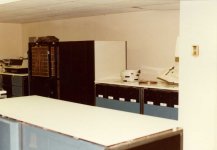RobS
Experienced Member
Yes, to exactly replicate logical operation of the H200 you would need a complete set of flow charts as explained on pages 3-10 and 3-11 of the Logic Manual. A former field engineer might still have these but I doubt that they are really necessary as you should be able to guess most of their contents and you would only need them if you were keen to replicate every nuance of the original machine rather than just the specified behaviour of it as given in the operation descriptions. It all depends how genuine you want your emulation to be.Regarding tediousness, I would think that a language such as VHDL could also leverage building blocks, such that you simply use blocks to construct the machine.
I was envisioning a way to represent the original hardware logic, but using modern tools. I was looking at the "Series 200 Logic Training Manual" that I downloaded from bitsavers. That seems to describe the CPU logic in enough detail to (perhaps) reconstruct it, but the major diagrams are missing from the scan (or are part of a separate document bundle that is not available - or else I don't understand the references made).
I believe the same process (that you have been using) would be followed, except that instead of physical hardware one uses the language features of something like VHDL. (I keep using "VHDL" here because it is one hardware language I know of, but I suspect it is not the latest or best supported anymore).
To understand my personal motivation you have to refer to my article written for the Computer Conservation Society here in the UK. There I explained that I just wanted to turn a big heap of electronic junk into a working machine so that I could give it away to someone else instead of having to pay for it to be recycled in an environmentally secure way as required by UK legislation. In the marketplace I think this activity is generally known as "value adding". By the way, that article isn't exactly as I wrote it as the editor of the magazine applied his own version of "value adding" to it without consulting me first. That's why I prefer to publish only on my own websites although that article gained me some interesting contacts.
I actually find the physical constraints of the project far more challenging than the logical ones. My design has to take into account a whole list of constraints that your approach probably wouldn't. Here are just some of them.
The limited number of pins on the very simple original ICs that I use.
The limited number of ICs that fit on one standard PCB.
The limited number of each type of IC that I have in my stockpile.
The cumulative propagation delays encountered in using chains of ICs.
The limited number of edge connector pins on each PCB.
The limited number of PCBs that will fit on one backplane.
The limited number of backplanes that I own.
Last and not least the appalling cost of getting integral edge connectors gold plated on new PCBs nowadays.
I am not acquainted with VHDL and don't know how all these constraints could be factored into a design while using it.
The appeal of the original H200 was that it was cleverly designed both up to a high specification and down to a low price. The economy exhibited in the logic design was impressive, which was probably why its chief designer, the late Dr. William L. Gordon, persistently described the machine as "elegant" to his family for the rest of his life according to his daughter. If you can work out the most elegant and economical way of designing the logic then that was most likely how the original design team did it if they were working to similar constraints.
If there were someone who would want to carry on with my project when I gave up on it then I would give them all the resources that I have for it but I doubt that such a person exists. I may still continue it to a logical end point to enable such a handover anyway if other commitments don't become more demanding just to find out whether what I have already designed actually works. The main memory is already operational and the control memory design still needs completion and proving, so I may go at least that far.


